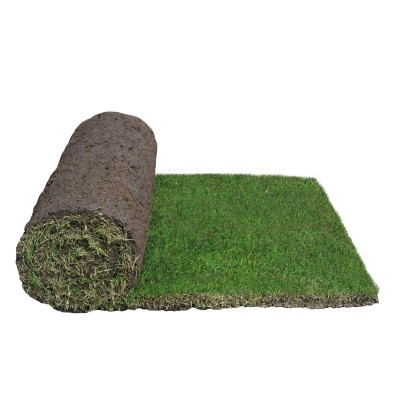The growth of grass is heavily dependent on the amount of sunlight the lawn receives. Just like trees and other plants, grass converts energy from sunlight into sugar through the process of photosynthesis. Warm season turf varieties including buffalo, couch, zoysia, and kikuyu love full sunlight and will thrive in well-lit areas. But with little sunlight turf can often struggle to grow.
In this blog, we will look at how grass grows, why grass needs sunlight, how much sunlight is needed for different varieties, and how you can manage shade on your lawn.
What makes grass grow?
Grass grows by using energy from the sun to produce sugar. This energy is then used to convert water and carbon dioxide into glucose. This carbon dioxide is absorbed through the leaf of the grass and water is mainly absorbed by the roots of the grass. After glucose is created it is used throughout the grass for growth. Oxygen is then released into the atmosphere as a by-product. This process is otherwise known as photosynthesis.

Why does grass need sunlight?
Just like all plants, grass too needs sunlight. Sunlight allows grass to produce the food your lawn needs to survive. Glucose, otherwise known as sugar, is produced by the grass and is used as food to help your lawn grow. Without sunlight, your lawn will not be able to produce glucose, causing the grass to thin out and die.
Grass also uses sunlight to produce a pigment called Chlorophyll. Chlorophyll absorbs light at two different wavelengths, blue light, and red light while reflecting green light. When light is present chlorophyll can then be produced.
In winter when there is less sunlight available, many types of grass will start to lose their green colour and can turn brown. When this occurs, this does not mean that the lawn is dying, it is just not receiving enough light to produce chlorophyll.
How much does sunlight does turf need?
While all turf varieties do need some sunlight to thrive, some are more shade tolerant than others. This means some varieties can better absorb sunlight than others.
Generally, the wider the leaf blade on the grass, the more shade tolerant a turf variety will be.
Sir Walter DNA Certified Buffalo
Sir Walter DNA Certified Buffalo tends to do better in shaded areas due to its soft broadleaf. This broadleaf allows the grass to absorb more sunlight due to a larger surface area. This grass can thrive in areas that receive as little as 3 to 4 hours of direct sunlight each day or speckled sunlight from trees for most of the day.

Sir Grange Zoysia
Sir Grange Zoysia is another shade tolerant variety. This is due to its slow growth habit. Sir Grange’s slower growth habit causes the turf to need fewer inputs, including sunlight. Once established, Sir Grange can thrive in areas that receive a minimum of 4 hours of direct sunlight per day.

TifTuf Hybrid Bermuda
TifTuf Hybrid Bermuda is a fast-growing fine leaf turf variety, needing at least 5 hours of direct sunlight. This variety has an increased gibberellic acid production. This results in a superior stimulation of photosynthesis, assisting in the plants’ ability to absorb sunlight, giving TifTuf a greater ability to absorb sunlight than other fine leaf couch varieties.

Eureka Kikuyu
Eureka Kikuyu is a sun loving turf variety that thrives in areas with full sun. This grass has a vigorous growth pattern, needing at least 5-6 hours of direct sunlight to thrive.

What should I do if my lawn isn’t receiving enough sunlight?
If your lawn is in a shaded area, we recommend regularly pruning back any trees, bushes, and other foliage around the lawn. This will help increase the amount of sunlight your lawn receives. If your lawn is shaded by the house or other structures, choose a shade tolerant turf variety that will be suited for your area.
For more information on choosing the best turf variety for your area, have a chat with your local turf supplier. You can find who your local turf supplier is here.
For more helpful lawn care information and advice, check out our blogs here.


